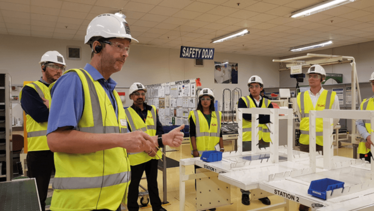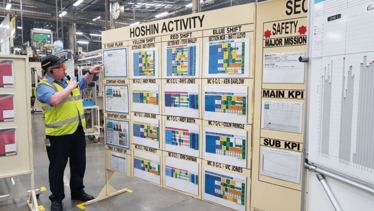Kaizen Chiefs
Pharma companies have ample room to improve productivity. Lean manufacturing and continuous improvement could be the key to success, and the automotive sector – Toyota, in particular – is a rich source of inspiration.
All pharma manufacturers face pressure to reduce prices, yet companies differ greatly in their efficiency. The most productive companies are twice as productive as the average, which means many businesses have plenty of room for improvement. And even the best must move forward to avoid being left behind. The keys to success can be found in lean manufacturing and continuous improvement. One company that takes these principles to heart, with impressive results, recently invited pharma businesses to see how they do it.
Medicine makers attended a “lean manufacturing” workshop and factory tour at Toyota’s Deeside Engine Plant in North Wales, UK. Toyota is widely regarded as the world’s most effective practitioner of continuous improvement and lean manufacturing; and although they make cars and engines, the automotive industry has already tackled many of the cost and efficiency challenges now facing pharma manufacturers, so there’s much we can learn from the sector. Here, I’ll share a brief overview of what was seen and discussed.
The SMMT (Society of Motor Manufacturers & Traders) Industry Forum, a specialist training and consultancy provider for manufacturers, co-hosted the workshop with Toyota. In addition to assisting automotive firms, the Industry Forum also helps transform manufacturing competitiveness in many diverse industries, including pharma. As Industry Forum’s Chief Executive, I was one of the workshop speakers in Deeside and was able to see first-hand how Toyota’s approach to manufacturing truly inspired our guests.
The 115-acre site at Deeside employs almost 700 people and produced more than 337,000 engines last year for the Toyota Auris and Auris Hybrid models. Deeside’s engines and component sets are shipped to Toyota car-building plants in Derbyshire (UK), South Africa, Turkey, Brazil, and Japan. Deeside is also home to the Toyota Lean Management Centre, which shares knowledge, understanding and experience with non-competitive organizations with a desire to develop people and processes. The Centre works with small, medium and large multinational companies in a wide range of sectors including food, chemicals, aerospace, and pharma. Toyota Deeside also provides unique opportunities for study and benchmarking.
Benchmarking can help pharma look at itself in the mirror objectively. According to McKinsey & Company’s research (1), pharma’s strengths are research and development, as well as sales and marketing, but the industry needs to build on these by improving productivity and reining-in costs. Inventory lead times need to be shortened and inventory levels must be slashed; manufacturing equipment and labor must be employed more efficiently; and waste caused by unplanned speed losses or stoppages on production lines must be reduced.
These are all challenges that Toyota has faced – and tackled successfully through lean manufacturing and the Japanese concept of “kaizen.” So let’s take a brief look at kaizen and four other cornerstones adopted by Toyota in the pursuit of manufacturing efficiency. At the Deeside plant, we saw some good examples of how these have helped make production-line working practices more standardized, reduced lead times, enabled better allocation of resources, reduced headcount in some areas so that it can be re-deployed to others, and improved overall plant productivity.



Five cornerstones
Toyota’s leadership style is founded on the principles of Plan, Do, Check, Action (PDCA). The company recognizes that leadership capability is essential to ensure that the tools of lean and human resources are deployed in harmony with one another. The aim is persistent leadership and the adoption of best practices by everyone.
The first cornerstone is “challenge.” It’s vital to have a medium- and long-term vision, which necessitates managing change. To ensure that the forward-looking vision is sharp, there has to be detailed study of manufacturing processes and capacity.
The second is “kaizen,” perhaps the most-used word in the Japanese business vocabulary. Kaizen denotes continuous improvement and has long been one of the major tools of the Toyota Production System. Kaizen is the process of making small improvements continuously by targeting the elimination of waste and none-value-added activities. Kaizen isn’t about efficiencies resulting in headcount reduction; quite the opposite, it’s about engaging, empowering and motivating employees (who Toyota refers to as “members”) at all levels to strive for perfection. In fact, every member is asked to come up with two improvement ideas per month and there’s a reward scheme for the best ideas. On the assembly line, members are rotated between four (of the six) different line tasks every day so that they stay engaged with the job and keep looking for ways to eliminate waste with fresh eyes. Because kaizen is practiced daily, the Toyota Production System constantly evolves. To encourage this, information about targets and performance is displayed prominently at many locations throughout Toyota’s plant.
The third is “hoshin kanri.” In corporate-speak, this means “policy deployment,” but to everyone in the workplace it means teamwork. And it’s how the company’s strategic goals drive progress and action at every level. Toyota uses hoshin as its starting point to align business strategy with shop floor activity, then deploys high-level strategy at all levels through daily management. What’s more, all levels in the company create their own hoshin, with assigned responsibilities.
“Genchi genbutsu” – “go and see” – is the fourth cornerstone. It spells out that it is imperative for managers to go to the production line and see whether individuals are all working to exactly the same, standardized methods. Standardized work is a tool that can be applied to any process where human interaction is present by organizing and defining process-steps and human movements. It ensures that safety, quality and efficiency are built into human processes. One Toyota manager told us, “We standardize everything, but we don’t stifle creativity, because the challenge for our members is to create the standard and then constantly improve it.”
It is the job of assembly line team leaders to observe that standardized procedures are adhered to. This manual monitoring is supplemented by the installation, and frequent re-location, of video cameras around the plant. Far from being the first step in a blame game, it is designed to better-direct mentoring and support. One manager told us, “Trust is essential. We’re not using the cameras to catch anyone out, but to bring improvements. We never blame the individual, we analyze and improve the process.”
Team leaders are also responsible for dealing with any line issues. If members experience abnormalities on the line, they are asked not to take countermeasures because these can cause more problems. Instead, it’s down to the team leader to make the fix, then bring members together to see how it was done.
The final cornerstone is “respect.” Toyota’s team-working mindset starts with the belief that everyone wants to do a good job. Each level of management ensures that high levels of operational performance are achieved on a daily basis through true teamwork, and the company regards itself as responsible for creating an environment in which people can develop and grow. A development map is created for every individual, with a clear path for training and advancement.
Continuous rewards
You might have heard some businesses say they “tried lean” and were disappointed with the results. But I suspect many such companies only half-heartedly adopted lean practices, limiting any potential impact to the bottom line. And if lean practices are not properly sustained, their efficiency gains will fizzle out. A common mistake made by under-performing businesses is to regard lean tools as an objective in themselves, rather than as a way to introduce a fundamentally new way of working – and, indeed, thinking.
Some of the many gains from implementing this way of thinking, as revealed on the factory tour, were mind-boggling. For example, a plant that produces 1,300 engines per day cut the number of engines stocked from 2,700 to 450 – and is now targeting 350! This is quite a contrast with the average pharma company, which holds 180 days’ of finished inventory, or even with top-performing pharma businesses, which typically hold about 100 days’ worth. Another example was a plant designed to produce an engine (with 25 variants) every 54 seconds that initially achieved a production rate of 57 seconds; now, it’s down to 42 seconds. It wasn’t necessary to make big investments to achieve this productivity gain; it happened, step-by-step, entirely through kaizen and eliminating waste.
It is true that some of the easiest and biggest gains will probably be made first, but after the low-hanging fruit, smaller rewards will be found by looking harder and further. But when every member of the company is looking and reaching, as they are at Toyota, small improvements keep coming in such large numbers that they add up to something significant. Why not implement similar best practices to reap the benefits of lean manufacturing and continuous improvement?
Chris Owen is Chief Executive of the SMMT Industry Forum.
If you are interested in learning more about kaizen and how Toyota can offer support in applying lean management techniques, contact: [email protected] (Toyota Lean Management Centre at Deeside). [email protected] (Lean approach seminars at Toyota Manufacturing UK Burnaston, Derby).
- McKinsey & Company, “Building New Strengths in the Healthcare Supply Chain,” (2013). Available at: bit.ly/2MgOLPH. Accessed September 10, 2018.
Chris Owen is Chief Executive of the SMMT Industry Forum.



















